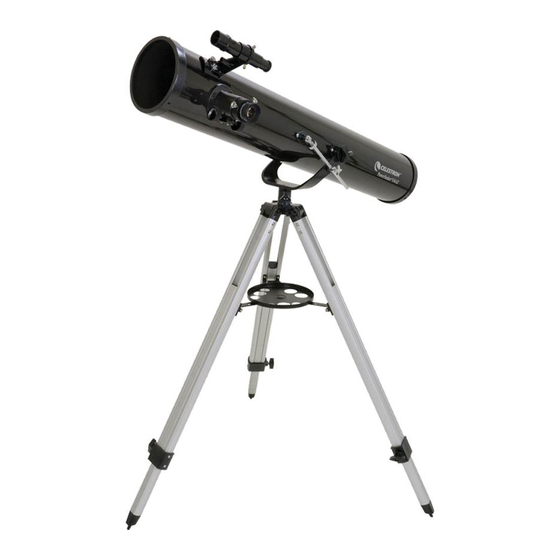
Summary of Contents for Celestron 21056-K
- Page 1 ® ® INSTRUCTION MANUAL Model # 21056-K...
-
Page 2: Table Of Contents
The PowerSeeker 114AZ carries a two year limited warranty. For details see our website at www.celestron.com Some of the many standard features of the PowerSeeker include: •... -
Page 3: Assembly
3 & 5 Figure 1-1 Shown PowerSeeker 76AZ (PowerSeeker 114AZ similar) Finderscope (PS 114AZ is different – see below) Azimuth Lock Eyepiece Accessory Tray Collimation Adjustment Screws (in rear) Tripod Telescope Optical Tube Alt-Az Mount Primary Mirror (inside rear cell) Altitude Lock Altitude Slow Motion Rod Assembly Focus Knob... -
Page 4: Mount
Figure 2-4 Figure 2-5 Figure 2- 6 The telescope optical tube attaches to the altazimuth mount with the altitude slow motion rod assembly and the respective knobs. Before starting, remove the front opening cap. To mount the telescope tube to the mount: Remove the protective paper covering the optical tube. -
Page 5: Installing The Eyepiece
The eyepiece (or ocular) is an optical element that magnifies the image focused by the telescope. Without the eyepiece it would be impossible to use the telescope visually. Eyepieces are commonly referred to by focal length and barrel diameter. The longer focal length (i.e., the larger the number) the lower the eyepiece magnification (i.e., power). Generally, you will use low-to-moderate power when viewing. -
Page 6: Telescope Basics
The star pointer is powered by a long life 3-volt lithium battery (#CR2032) located underneath the front portion of the Star Pointer. Like all finderscopes, the Star Pointer must be properly aligned with the main telescope before it can be used. This is a simple process using the azimuth and altitude control knobs located on the side and bottom of the Star Pointer. -
Page 7: Calculating Magnification
You can change the power of your telescope just by changing the eyepiece (ocular). To determine the magnification of your telescope, simply divide the focal length of the telescope by the focal length of the eyepiece used. In equation format, the formula looks like this: Focal Length of Telescope (mm) ⎯⎯⎯⎯⎯⎯⎯⎯⎯⎯⎯⎯⎯⎯⎯⎯⎯⎯⎯⎯⎯⎯... -
Page 8: Motion Of The Stars
Figure 4-1 The celestial sphere seen from the outside showing R.A. and DEC. The daily motion of the Sun across the sky is familiar to even the most casual observer. This daily trek is not the Sun moving as early astronomers thought, but the result of the Earth's rotation. -
Page 9: Celestial Observing
• To increase contrast and bring out detail on the planetary surface, try using Celestron eyepiece filters. Although overlooked by many amateur astronomers, solar observation is both rewarding and fun. However, because the Sun is so bright, special precautions must be taken when observing our star so as not to damage your eyes or your telescope. - Page 10 Figure 5-1 Star hopping to the Andromeda Galaxy (M31) is a snap, since all the stars needed to do so are visible to the naked eye. Star hopping will take some getting used to and objects that don’t have stars near them that are visible to the naked eye are challenging. One such object is M57 (Figure 5-2), the famed Ring Nebula.
-
Page 11: Seeing Conditions
During the last few years a new technology has evolved which makes taking superb images of the planets and moon relatively easy and the results are truly amazing. Celestron offers the NexImage (# 93712) which is a special camera and included is software for image processing. You can capture planetary images your first night out which rivals what professionals were doing with large telescopes just a few short years ago. -
Page 12: Telescope Maintenance
This will prevent contaminants from entering the optical tube. Internal adjustments and cleaning should be done only by the Celestron repair department. If your telescope is in need of internal cleaning, please call the factory for a return authorization number and price quote. - Page 13 Night Time Star Collimating After successfully completing daytime collimation, night time star collimation can be done by closely adjusting the primary mirror while the telescope tube is on its and pointing at a bright star. The telescope should be set up at night and a star's image should be studied at medium to high power (30-60 power per inch of aperture). If a non-symmetrical focus pattern is present, then it may be possible to correct this by re-collimating only the primary mirror.
-
Page 14: Optional Accessories
Visit the Celestron website or the Celestron Accessory Catalog for complete descriptions and all accessories available. Sky Maps (# 93722) – Celestron Sky Maps are the ideal teaching guide for learning the night sky. Even if you already know your way around the major constellations, these maps can help you locate all kinds of fascinating objects.














Need help?
Do you have a question about the 21056-K and is the answer not in the manual?
Questions and answers